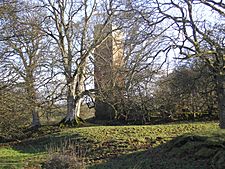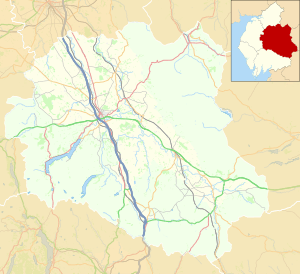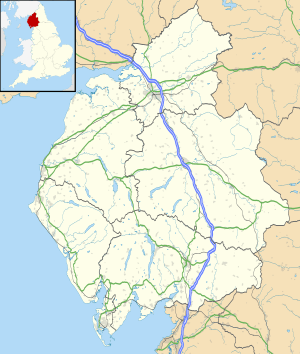Kirkoswald Castle facts for kids
Quick facts for kids Kirkoswald Castle |
|
|---|---|
| Kirkoswald, Cumbria, England | |

The remains of Kirkoswald Castle
|
|
| Coordinates | 54°45′43″N 2°41′11″W / 54.7620°N 2.6863°W |
| Type | Fortified manor house |
| Site history | |
| Materials | Red sandstone |
Kirkoswald Castle is an old castle found in the village of Kirkoswald, Cumbria, England. It was built using red sandstone from Penrith. Today, parts of the castle still stand, showing its long history.
Contents
The Castle's Story
Building and Early Days
In 1201, King John gave permission for a manor house to be built here. This special permission was called a "licence to crenellate." It meant the owner, Hugh de Morville, could add battlements and defenses to his home. This made it look more like a castle.
Attacks and Rebuilding
The castle faced tough times. In 1314, Scottish forces attacked and destroyed it. But the owners didn't give up! They rebuilt the castle just three years later, in 1317.
Changes Over Time
The castle grew much larger in 1485. A moat was also added around it for extra protection. A moat is a deep, wide ditch, often filled with water, that surrounds a castle.
Later, in 1525, after the owner Thomas Dacre passed away, some beautiful parts of the castle were moved. Things like stained glass windows, wooden wall panels, and special beamed ceilings were taken to Naworth Castle.
Dismantling and Listing
Between 1610 and 1688, Kirkoswald Castle was taken apart. This means many of its stones and materials were removed. The castle was officially recognized as an important historical site on December 27, 1967.
What's Left Today?
Today, Kirkoswald Castle stands on farm land. You can still see parts of the old buildings, including a tower. The moat is also still visible around the site.
A public footpath runs right next to the castle ruins. For your safety, it is important not to enter the actual castle site.
The castle ruins are very important. They are listed as a Grade II listed building in the National Heritage List for England. This means they are protected because of their historical value. The ruins and the moated area are also a Scheduled Monument. This gives them even more protection as a nationally important archaeological site.




